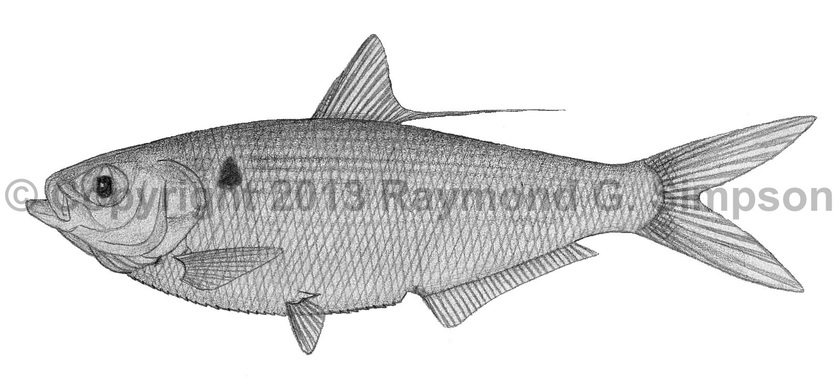
Common Name
Threadfin Shad
Year Described
Günther, 1867
Identification
Dorsal Fin: 11-14
Anal Fin: 17-27
Pectoral Fin:
Pelvic Fin: 7-8 (6-7 branched)
Vertebrae: 40-45
Lateral Line Scales: 41-48
Ventral Scutes: 23-29
Gill Rakers: 400+ (first arch in adults)
Body fusiforme and compressed. Mouth terminal and very small. Jaw does not reach eye. Front of upper jaw notched (unique to Dorosoma, Alosa, and Brevoortia. Lower jaw fits into notch in upper. Dorsal fin single with a filamentous final ray. Pelvic fin origin under dorsal fin origin. Anal fin begins behind last dorsal ray with a moderately long base and low. Tail forked. Body fully scaled. Keel strongly convex.
Color
Bright silvery body with a bluish back. A black spot behind the upper gill cover. Dorsal and caudal fins dusky to yellowish. Other fins transparent to yellowish.
Size
Maximum size to 23cm TL. Usually 10-18cm SL.
Habitat
Usually in freshwater rivers but also in brackish bays. Juveniles only in freshwater.
Range
Gulf of Mexico drainages from Florida to the Yucatan. Extends south to Belize along the Caribbean coast. Introduced along the U.S. east coast and elsewhere.
References
McEachran, J.D. & J.D. Fechhelm. 1998. Fishes of the Gulf of Mexico. Volume 1: Myxiniformes to Gasterosteiformes. University of Texas Press, Austin. i-viii + 1-1112.
Miller, R.R. 1950. A review of the American clupeid fishes of the genus -Dorosoma. Proceedings of the United States National Museum. Vol 100. No. 3267: 387-410.
Munroe, T.A. & M.S. Nizinski. 2002. Clupeidaeidae (pp 804-830). In: Carpenter. 2002. The living marine resources of the Western Central Atlantic. Vol. 2: Bony fishes part 1 (Acipenseridae-Grammatidae). FAO Species Identification Guides for Fisheries Purposes. American Society of Ichthyologists and Herpetologists Special Publication No. 5.
Other Notes
The only Dorosoma in the area with a terminal mouth, <25 anal fin rays, and <50 lateral line scales. The only other genus of thread herrings is Opisthonema oglinum, which does not have a notched upper jaw.